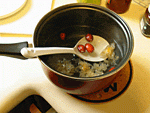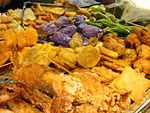Dietary Advice For The Five Body Constitutions
TCM takes active measures to alter the physical constitution and promote health. According to its holistic concept, all aspects of a person's lifestyle including work, relationships, and daily habits are linked to health. The physical constitution of a person is determined by physiological functions, organic structures, and internal balances as well.
Below are dietary advices for commonly five body constitutions: neutral, yin and cold, yang and hot, phlegm and dampness, and dry.
| Body type | Dietary Advice | Food examples |
| Yang and hot | Foods with cool or cold energy, or having bitter flavor are appropriate. Pungent, spicy and deep fried foods should be taken in moderation, sample ingredients are chili, ginger, and beef. Alcohol is pungent and hot in nature, so people with excessive yang should refrain from alcohol. |
Duck, processed jellyfish, crab, sesame, carrot, banana, watermelon, persimmon, pear, grapefruit, lily bulb, mung bean, white fugus, bitter gourd, winter gourd, stem lettuce, bamboo shoot, amaranth, Chinese kale, tomato, lotus root, laver, kelp, spinach and celery. **Individuals are encouraged to eat more fruits and vegetables. |
| Yin and cold | Foods with hot or warm energy, and having sweet and pungent flavors are appropriate. Yin and cold foods should be taken in moderation. |
Chicken, goose, beef, mutton, daily products, eels, crucian carp, ribbonfish, garlic chives, mustard, lettuce, garlic, dates, longan, litchi, peach, chestnut, plum, apricot, grapes, cane sugar, pumpkin, mushroom and ginger. **Individuals are encouraged to eat foods with higher energy level. |
| Phlegm and dampness | Foods that have a drying effect, benefit the spleen and stomach, and help to expel dampness and phlegm evils are suitable. Don't overeat, avoid fat, alcohol and sweet foods should be taken in moderation. |
Radish, celery, coriander, spinach, winter gourd, amaranth, cabbage, water chestnut, laver, processed jellyfish, onion, loquat, ginkgo nut, Chinese dates, hyacinth bean, broad bean, lotus seed, barley, seaweed, asparagus, barley, corn silk, cucumber, plum, maltose and Chinese yam. |
| Dry |
Individuals' diet should be light. Foods that aid lubrication and promote body fluid production are suitable. Hot, dried and greasy food should be avoided. |
Animal livers, pork, fishes, bean curd, egg, dairy products, yellow soybean, glutinous rice, lily bulb, white fungus, sesame, nuts, dates, sugar cane, spinach, pear, apple, apricot, coconut, lemon, peach, plum, strawberry, tomato, brown sugar, crystal sugar, and honey. |
| Neutral |
A diet that blends with different energies and flavors, and contains a wild range of selections are appropriate. | - |
The criteria for selecting food according to the body constitutions is to balance the body's yin yang. For example, if a person with a hot body constitution (that means his "internal heat" predominates) eats cold foods, the cold energy of the food is absorbed into his body thus reducing the previously excessive internal heat. Regular consumption like this helps balance the internal environment and the physical constitution will turn to neutral gradually.
The Chinese believe cooking food is also an important process in aiding digestion and promoting health. Firstly, it makes the food easy to absorb; and secondly, cooking alters the nature of food so that it caters to individual needs.
Some rules in cooking:
- Use fresh, organic and seasonal foods;
- Prepare and blend foods and recognize the need for an energetic balance;
- Cook food lightly and serve warm to make digestion easier;
- Steaming, poaching and boiling helps alter the nature of the food to more yin;
- Deep-fat frying, stir-frying and roasting helps alter the nature of the food to more yang.
 |
 |
| Poaching method makes food more yin. | Deep-fat frying makes food more yang. |
References
- Chinese System of Food Cures Prevention & Remedies by Henry C. Lu.Sterling Publishing Co., Inc. 1986.
- The Tao of Food, Richard Craze and Ronifjay, 1999 Godsfield Press.
- Chinese Food: a Holistic Therapy by Tom Neuhaus, www.hopedance.org
- Medicinal Food in China by Junshi Chen, M.D. http://newcenturynutrition.com
- Cooling the Summer with Food: An Introduction to Medicinal Foods by Yanfang Wang, M.D., Ph.D. http://newcenturynutrition.com
Written By:
Dang Yi (黨毅) MD PhD
Professor, Beijing University of Chinese Medicine;
Visiting Professor, Middlesex University, London, UK;
Vice Director, Gourmet Food Institute of Health Care and Nutrition of Beijing, PRC.
Editors:
Raka Dewan, Integrated Chinese Medicine Holdings Ltd.
Rose Tse, Integrated Chinese Medicine Holdings Ltd.


